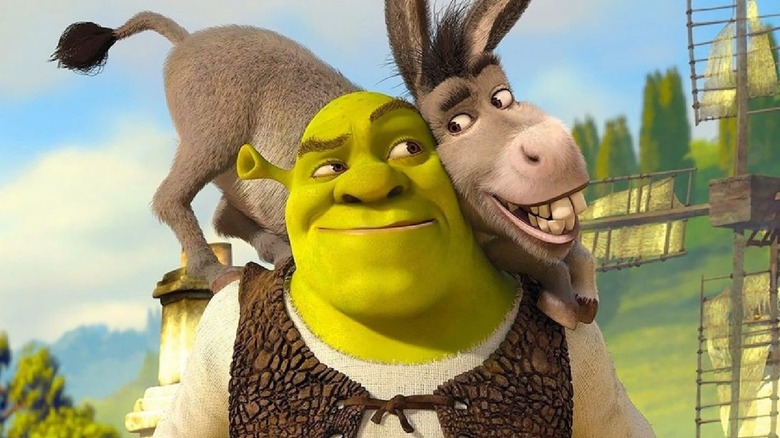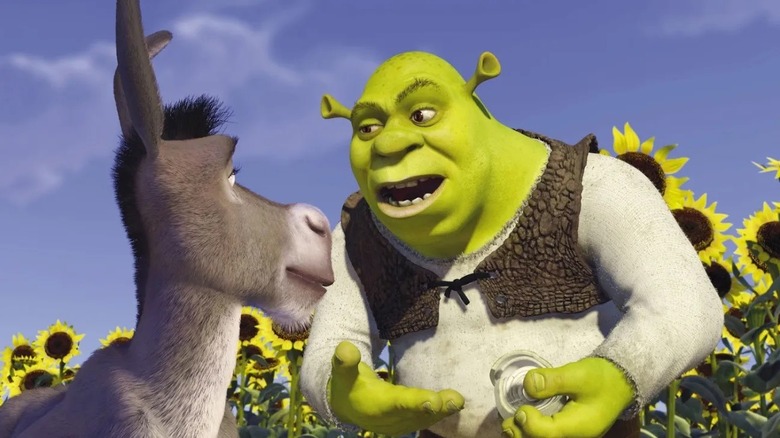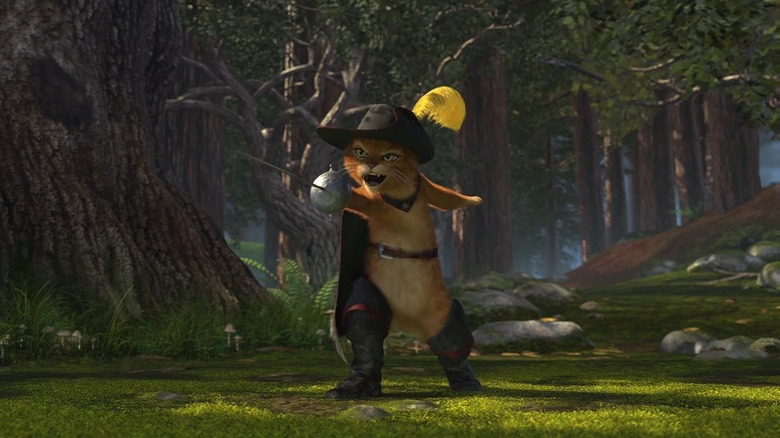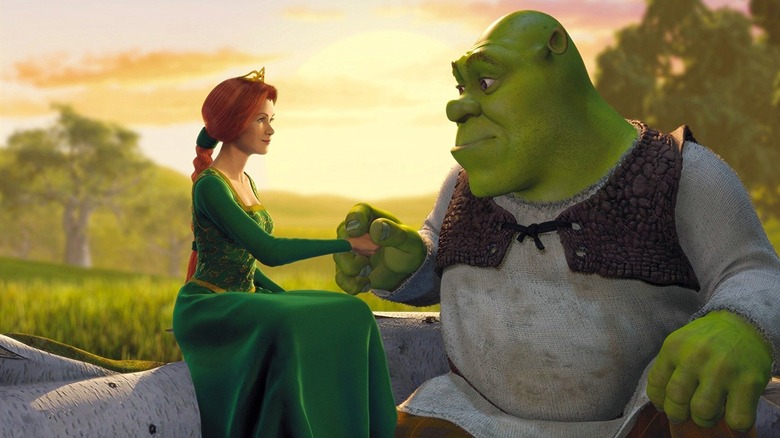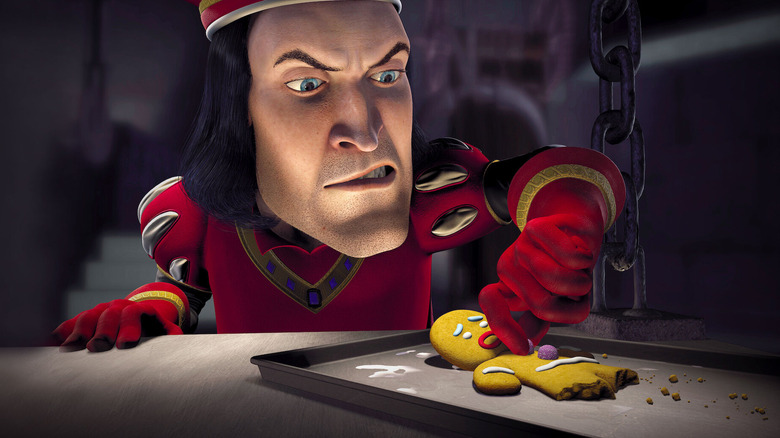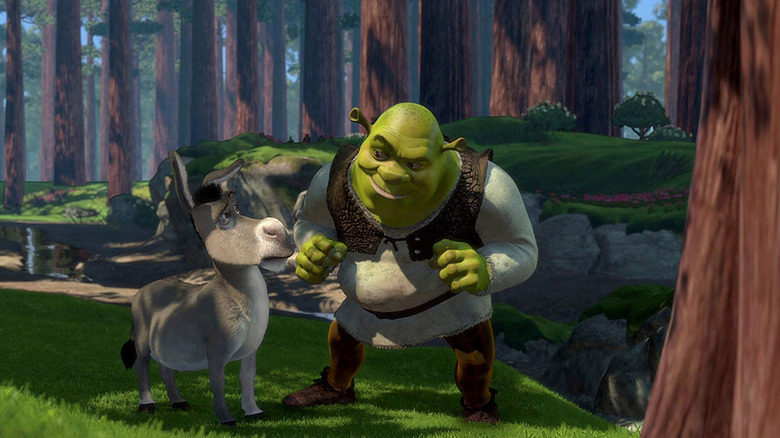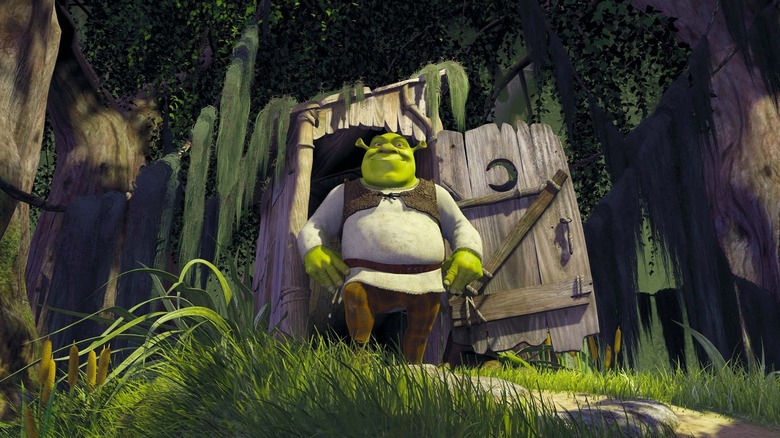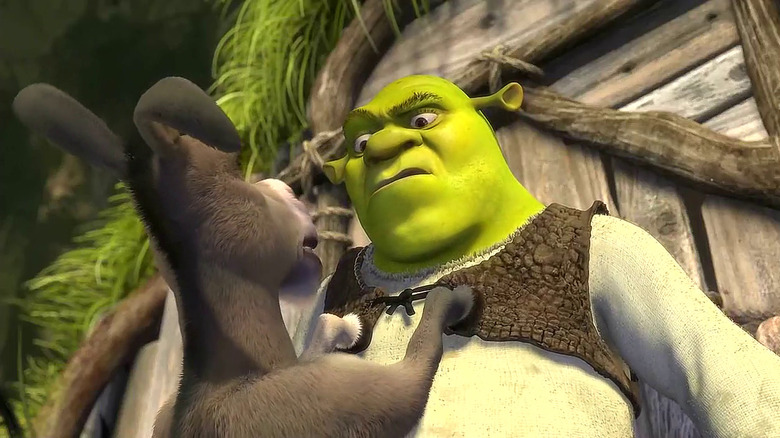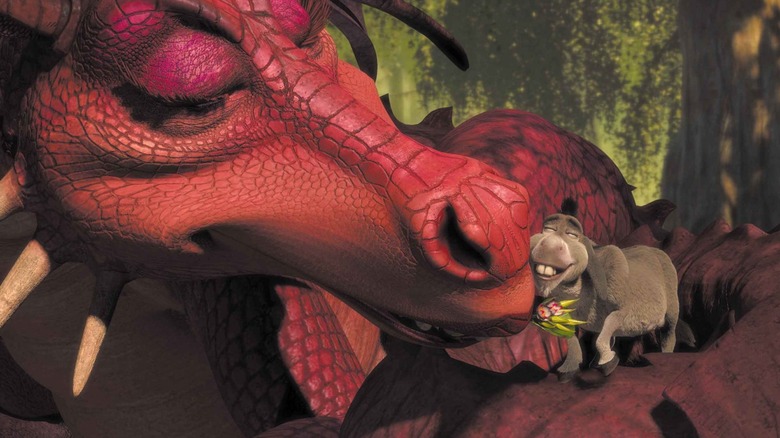Shrek: 9 Biggest Differences Between The Movies And The Book
Movie adaptations of books are not good because they follow every word of the text. On the contrary, the greatest adaptations are more like translations of their source material. They find inspired ways to bring what works in one medium to another form of artistic expression, which includes changing details once thought indispensable by readers. So it was with 2001's "Shrek," a movie based on William Steig's 1990 children's book "Shrek!" The 30-page book is an exceedingly simple, albeit strikingly written and illustrated, work about a hideous ogre causing chaos in his pursuit of a princess that's as ugly as he is.
The appeal of building a story around an unabashedly grotesque character is immediately apparent, and it's no wonder the folks at DreamWorks Animation were captivated by this story. Expanding it into a feature-length narrative, however, required extensive work that entailed creating so many new details and character beats from the ground up. There's no shortage of variations between "Shrek" and its source material, but the nine biggest alterations exemplify just how much had to change in bringing "Shrek!" to the big screen.
That includes elements of the final film now considered essential, including the personalities of Fiona and Donkey, or the way the movie lampoons the standard tropes of fairy tale stories. Those are all just the tip of the iceberg in how "Shrek!" was renovated for its adaptation to the screen. Above all else, these differences vividly demonstrate why it's necessary to often change the source text when making crowdpleasing movies for the ages.
Shrek's parents are emphasized in the book
William Steig's "Shrek!" has a chronological approach to exploring its title character's life. That includes starting the text with young Shrek living with his parents, as indicated by the book's very first words: "His mother was ugly and his father was ugly, but Shrek was uglier than the two of them put together." Shrek's folks, who remain unnamed, consist of a yellow-skinned male ogre and a purple-skinned female ogre. Eventually, the pair kick Shrek out of their home so that he can spread mayhem and grossness throughout the land, which ends the role of our hero's parents in the original "Shrek!" text.
Presumably to emphasize how lonely the movie version of the character is, "Shrek" begins with a fully grown iteration of its protagonist (voiced by Mike Myers) and makes no mention of his parents. The concept of seeing Shrek's parents and upbringing, though, seemed to fascinate key people involved in the "Shrek" franchise. Former DreamWorks Animation head Jeffrey Katzenberg even said in 2007 that a fourth "Shrek" installment would explore those early days, presumably taking one or two cues from the opening lines of William Steig's text.
However, those plans never materialized and Shrek's parents have remained off-screen for the time being. This franchise has been more interested in expanding the big green ogre's world rather than looking back at his past. After all, there's no Donkey or Puss in Boots in Shrek's childhood. Thus Shrek's parents only exist in the children's book that started this whole saga.
No sign of Puss in Boots
If the original "Shrek" only bore the faintest resemblance to its source material, "Shrek 2" was practically sent from a whole other planet compared to the William Steig text. Unsurprisingly, after the first film became one of the highest grossing motion pictures of 2001, director Andrew Adamson and company opted to make "Shrek 2" an even bigger version of its rowdy, self-referential predecessor, not to mention a derivative of "Guess Who's Coming to Dinner?," rather than drawing on more material from the book. This makes it a foregone conclusion that Puss in Boots doesn't appear at any point within "Shrek!"
There aren't even any cats in "Shrek!" that one could view as a potential starting point for Puss in Boots. A two-page illustration in the book showing a bevy of critters and humans fleeing Shrek as he roams the countryside depicts multiple rabbits, pigs, a cow, and even a dog evading his presence. There are no cats in this drawing, however, nor in any other part of "Shrek!" There was no room for felines in this simple picture book, which made Puss in Boots an even more out-of-nowhere creation for "Shrek 2."
Yet this example of the "Shrek" franchise's distance from its source material has become one of the saga's most famous elements. Puss has even headlined two lucrative spin-off movies, including 2022's acclaimed "Puss in Boots: The Last Wish." Not bad for somebody with no roots in Shrek's first published adventure.
Fiona gets a name in Shrek
As Shrek memorably tells Fiona (Cameron Diaz) in the first "Shrek," "I'm a delivery boy." This cantankerous ogre simply means to retrieve the princess and bring her back to Lord Farquaad (John Lithgow). In "Shrek!," though, a witch tells Shrek his fortune and informs him that a downright hideous princess exists who will become his wife. He immediately sets off on his quest to meet this lady, with no intention of "delivering" her to another man. At the book's end, Shrek encounters a purple-skinned princess who's just as monstrous as him. The pair instantly fall in love and are married in a ceremony officiated by a pink crocodile in the book's final illustration.
In the book, Shrek's love is only referred to as "the princess," even when she's expressing romantic poetry about how much she likes Shrek's most gag-inducing physical features. There is no proper name for this character, let alone a rich backstory about her personality and worldly experiences. For the film adaptation, "the princess" became Fiona, and her existence now centers on her becoming an ogre only at night rather than being a monster full-time. It was an inevitable change on many fronts, including how Shrek and Fiona now meet halfway through the movie instead of at the end as in the original book.
To produce more drama and give this character more depth in a feature-length movie, "the princess" in "Shrek!" got significantly fleshed out, while adding some sweet kung-fu skills.
Fairy tale creatures were saved for the big screen
William Steig's "Shrek!" does skewer some fairy tale conventions, like a knight being an antagonistic force in the book's final pages or a dragon (usually the insurmountable foe of any fable) being ultimately powerless against Shrek's hideousness. However, these are more generalized punctures of the fairy tale balloon. There are no cameos from recognizable fairy tale characters, and the book's plot doesn't intersect directly with any vintage Brothers Grimm yarns. This means some of the most memorable elements of the original two "Shrek" films were made for the big screen, like the Gingerbread Man (Conrad Vernon) and Pinocchio (Cody Cameron).
It's hard to comprehend any version of "Shrek" devoid of the "muffin man" monologue or the chattering of those German pigs, but the compact scale of the book meant it didn't have much room for an ensemble cast, let alone countless fairy tale character cameos. Plus, these comedic parodies of the Seven Dwarfs, Three Blind Mice, and other characters were a result of the larger culture that 2001's "Shrek" was conceived in. Producer Jeffrey Katzenberg's history of running Disney (plus his subsequent negative relationship with the company) has led to people interpreting the deluge of jokes mocking fairy tale conventions in "Shrek" as reflective of Katzenberg's 21st-century hostility to the Mouse House.
Whether true or not, post-'90s cynicism about classic Disney musicals certainly helped "Shrek'" characters like Gingy feel extra relevant and gave it another layer of personality separating it from Steig's "Shrek!"
The movie made Donkey a chatterbox
In "Shrek!," Donkey is an explicitly restrained creation existing just to get Shrek to the princess, provided he says the magic phrase "apple strudel," of course. Though the ogre does label Donkey a "jabbering jackass" after the creature spouts a five-line poem, that's the extent of Donkey's mouthiness. He vanishes from the book the moment Shrek reaches the princess's castle, and there aren't extended stretches of the story dedicated to his excessive talking.
The folks behind the movie "Shrek" took that "jabbering jackass" line to heart in creating the silver screen incarnation of Donkey. Not only does the character get a greatly expanded role in the story as Shrek's best pal, but his entire personality centers on how he won't shut up. By making Donkey an inexplicably magic talking donkey, the character's underlying joke now turns into how the most wondrous sights can become annoying in the blink of an eye. Plus, this personality trait lets voice-over performer Eddie Murphy revel in his gifts for both improv and comedic timing. With Donkey constantly spouting off humorous lines, there are endless opportunities for Murphy to leave viewers rolling in the aisles, even when he's just humming a tune.
Those chances for unforgettable comedy wouldn't have existed if the "Shrek" creative team had kept Donkey confined to the same purpose he had in the original book. A "noble steed" became so much more once these screenwriters and Eddie Murphy injected him with energy and a bottomless supply of witty lines.
Movie Shrek has a more complex internal world
The key thing about the movie version of Shrek is that he's an abrasive loner on the outside who's secretly frustrated that the world "judges me before they even know me." That's what makes it so heartbreaking for him when he erroneously thinks that Fiona is secretly calling him ugly. Believing he has finally found somebody who accepts him for who he is, she becomes in his mind just another person who sees him on surface-level terms. "Shrek!," meanwhile, doesn't feature many self-reflective and angst-ridden moments with its titular ogre. On the contrary, Shrek here largely takes other people's fear and hatred of him in stride. He even seems to revel in it as he romps through the countryside.
The only instance of the book's Shrek having any self-consciousness about his looks is towards the end of "Shrek!" when he becomes trapped in a room of mirrors and stands face to face with what he believes is an ugly monster. Save for that, the initial version of Shrek has no qualms about his appearance, and he never once curses society for making him an outcast.
This is yet another change to "Shrek!" clearly made for creating both drama and rich enough characters that can sustain a 100-minute movie. Plus, giving this guy "layers" of resentment at the world makes Shrek's bonds with characters like Donkey all the more special. He finally develops the kind of emotional connections that the lead character on the page has absolutely no interest in.
Book Shrek can breathe fire
Those who read "Shrek!" after watching the film adaptation may be mildly surprised to learn how short the story is or how much of Shrek's personality was made up for the movie. But what will be instantly shocking is the book's declaration in one of its opening lines that "by the time he toddled, Shrek could spit flame a full ninety-nine yards and vent smoke from either ear." You read that right: the book incarnation of Shrek has superpowers like the ability to breathe fire. He uses this skill throughout "Shrek!" for tasks like dispatching a knight, while another scene shows him using something tantamount to heat-vision to freshen up a peasant's meal.
The enhanced nature of Shrek means that he can even do things like gobble up lightning bolts without blinking or contend with a dragon with ease. In the realm of movies, Shrek is certainly more durable than the average human, but he's decidedly not super-powered. He can't breathe fire whatsoever, and he can be overwhelmed by groups of mortal men in combat.
Ditching Shrek's super-powered qualities was likely a maneuver to make the character more relatable to audiences. Plus it ensured that Shrek couldn't just resort to breathing fire to solve every problem on his road to Fiona. It's a sensible change, but also one that makes reading "Shrek!" a disorienting experience for those accustomed to the DreamWorks films. The William Steig text is truly a whole other, more stylized creation.
A knight guards the princess, not a dragon
When Shrek (riding atop Donkey) finally arrives at the princess's castle in "Shrek!," waiting there for him is an unnamed knight ready to slaughter anyone who dares cross him. Folks privy only to the "Shrek" movie franchise will be surprised to see this dedicated knight, since a key part of that first film is how Fiona is stuck in "the highest room in the tallest tower" guarded by a "fire-breathing dragon." Here, though, just a knight separates the captured princess from the outside world. Despite this knight putting on a grand display of bravado, Shrek quickly dispatches him by using his fire-breathing powers to send the now-scalded guy screaming into the nearby moat. With that, Shrek trots into the castle without ever looking back at his fleeing foe.
The prototype for the "Shrek" character Dragon in "Shrek!" comes earlier in the book, as an orange-skinned dragon eager to rip off Shrek's head. The ogre, however, uses "a putrid blue flame" to render the scaly creature "unconscious for the day." While Shrek still faces a dragon in the book, this creature is just another obstacle in the woods rather than a direct protector of the princess.
Additionally, this dragon is introduced pages before Donkey's first appearance. The two characters never cross paths in "Shrek!," further separating this gigantic reptile from its later incarnation. Without having to contend with a dragon guarding Fiona, "Shrek!" is already a wildly different beast compared to the movie.
The movie has more modern sensibilities
"Shrek!" is a slightly post-modern text in how it upends certain fairy tale conventions. Specifically, the depiction of knights and dragons (typically the sources of power in these stories) as creatures who are easily defeated when facing Shrek's enormous strength especially registers as a subversive choice. However, it's largely a classical tale removed from any specific era of history. William Steig's writing style could be from the 1940s or '70s rather than 1990. This lends a timeless sensibility to "Shrek!" that nicely complements how idiosyncratic (and not immediately evocative of the '90s) its illustrations are.
Arguably, the biggest shift from book to the big screen for "Shrek" is in embracing an exceedingly modern aesthetic. "Shrek" directors Andrew Adamson and Vicky Jenson absolutely revel in an atmosphere that just screams 2001, right from the opening Smash Mouth needle drop. Characters do the "Macarena" in the climactic dance party, while individuals like Donkey use all kinds of modern verbiage in their witty quips. Whereas "Shrek!" snuck some unexpected turns and intentionally abrasive illustrations into a classical fairy tale world, "Shrek" is entirely about injecting 21st-century snark into realms defined by The Brothers Grimm and Walt Disney.
Going this route ensures that both versions of "Shrek" offer something new to audiences. Rather than being mere echoes of each other, "Shrek!" and "Shrek" flourish by offering wildly unique pleasures for varying artistic sensibilities. Plus, eschewing its source material's timelessness certainly made "Shrek" a movie that powerfully resonated with 2001 audiences — and has managed to stick around ever since.
